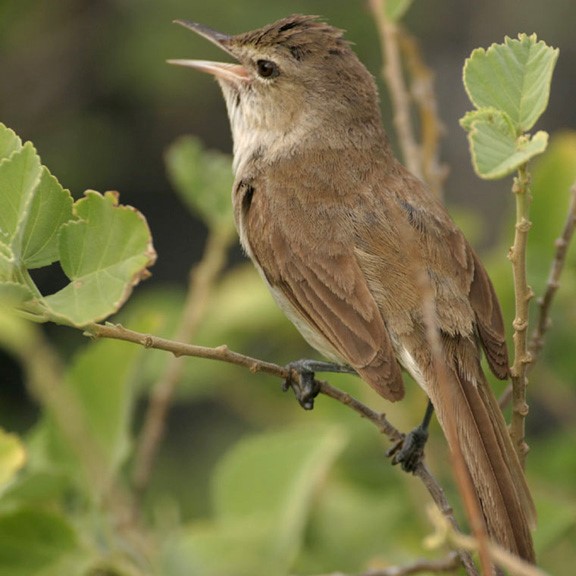Acrocephalidae: Reed-Warblers
The reed-warblers are a confusing group of drab songbirds, most of which inhabit marshes. Habitat is not a family-defining feature for them, however, as many species have other preferences. What most share in common is their appearance: a long, thin bill, brownish upperparts, whitish underparts, and a faint eyebrow stripe. They are difficult to identify by sight, and difficult to see as they tend to remain hidden in dense grasses or brush, so voice is often the key to identification.
Recognition of the reed-warblers as a family resulted from advances in genetic research, which revealed that the “Old World warbler” family (the former Sylviidae) was an assemblage of similar-looking groups that were not one another’s closest relatives. That analysis has led to the subdivision of former sylviid groups into seven to ten families, consistent with their ancestries.
Taxonomy
The Acrocephalidae include three groups that were each traditionally regarded as a genus: Madagascan brush-warblers (Nesillas), African yellow warblers (Chloropeta—no longer in use), and the widespread reed-warblers (Acrocephalus) which occur throughout the Old World and on a large number of Pacific Islands east to the Pitcairn Archipelgo. A fourth traditional genus (Hippolais) which are mostly arboreal, mostly European-breeding species, is also included, but genetic evidence has resulted in allocation of its members between the African yellow group and the reed-warblers.
Species limits in the Acrocephalidae have been fairly stable over time—although any bird family in which the species are so outwardly uniform is bound to include some borderline cases and cryptic diversity, so future reassessments seem likely. As currently understood, the family comprises approximately 56 to 59 species, plus seven or eight recently extinct.
Malagasy Brush-Warbler (Nesillas typica)
Subdesert Brush-Warbler (Nesillas lantzii)
Anjouan Brush-Warbler (Nesillas longicaudata)
Grand Comoro Brush-Warbler (Nesillas brevicaudata)
Mohéli Brush-Warbler (Nesillas mariae)
Aldabra Brush-Warbler (Nesillas aldabrana) †
Thick-billed Warbler (Arundinax aedon)
Papyrus Yellow Warbler (Calamonastides gracilirostris)
“Papyrus Yellow Warbler” (C. g. gracilirostris)
“Zambian Yellow Warbler” (C. g. bensoni)
African Yellow Warbler (Iduna natalensis)
Mountain Yellow Warbler (Iduna similis)
Booted Warbler (Iduna caligata)
Sykes’s Warbler (Iduna rama)
Western Olivaceous Warbler (Iduna opaca)
Eastern Olivaceous Warbler (Iduna pallida)
Upcher’s Warbler (Hippolais languida)
Olive-tree Warbler (Hippolais olivetorum)
Melodious Warbler (Hippolais polyglotta)
Icterine Warbler (Hippolais icterina)
Sedge Warbler (Titiza schoenobaenus)
Aquatic Warbler (Titiza paludicola)
Moustached Warbler (Titiza melanopogon)
Speckled Reed-Warbler (Titiza sorghophila)
Black-browed Reed-Warbler (Titiza bistrigiceps)
Paddyfield Warbler (Notiocichla agricola)
Manchurian Reed-Warbler (Notiocichla tangorum)
Blunt-winged Warbler (Notiocichla concinens)
Blyth’s Reed-Warbler (Notiocichla dumetorum)
Large-billed Reed-Warbler (Notiocichla orina)
Marsh Warbler (Notiocichla palustris)
African Reed-Warbler (Notiocichla baeticata)
Mangrove Reed-Warbler (Notiocichla avicenniae)
Eurasian Reed-Warbler (Notiocichla scirpacea)
“Eurasian Reed-Warbler” (N. s. scirpacea)
“Siwa Reed-Warbler” (N. s. ammon)
Caspian Reed-Warbler (Notiocichla fusca)
Basra Reed-Warbler (Acrocephalus griseldis)
Cape Verde Swamp-Warbler (Acrocephalus brevipennis)
Lesser Swamp-Warbler (Acrocephalus gracilirostris)
Greater Swamp-Warbler (Acrocephalus rufescens)
Seychelles Swamp-Warbler (Acrocephalus sechellensis)
Madagascan Swamp-Warbler (Acrocephalus newtoni)
Rodrigues Swamp-Warbler (Acrocephalus rodericanus)
Great Reed-Warbler (Acrocephalus arundinaceus)
Oriental Reed-Warbler (Acrocephalus orientalis)
Clamorous Reed-Warbler (Acrocephalus stentoreus)
“Clamorous Reed-Warbler” (A. s. stentoreus)
“Brown Reed-Warbler” (A. s. brunnescens)
Nightingale Reed-Warbler (Acrocephalus luscinius) †
Saipan Reed-Warbler (Acrocephalus hiwae)
Australian Reed-Warbler (Acrocephalus australis)
Aguiguan Reed-Warbler (Acrocephalus nijoi) †
Caroline Reed-Warbler (Acrocephalus syrinx)
Bokikokiko (Acrocephalus aequinoctialis)
Southern Marquesan Reed-Warbler (Acrocephalus mendanae)
Pagan Reed-Warbler (Acrocephalus yamashinae) †
Nauru Reed-Warbler (Acrocephalus rehsei)
Millerbird (Acrocephalus familiaris)
“Laysan Millerbird” (A. f. familiaris) †
“Nihoa Millerbird” (A. f. kingi)
Pitcairn Reed-Warbler (Acrocephalus vaughani)
Henderson Reed-Warbler (Acrocephalus taiti)
Cook Islands Reed-Warbler (Acrocephalus kerearako)
Rimatara Reed-Warbler (Acrocephalus rimitarae)
Society Islands Reed-Warbler (Acrocephalus musae) †
Tahiti Reed-Warbler (Acrocephalus caffer)
Moorea Reed-Warbler (Acrocephalus longirostris) †
Northern Marquesan Reed-Warbler (Acrocephalus percernis)
Tuamotu Reed-Warbler (Acrocephalus atyphus)
Mangareva Reed-Warbler (Acrocephalus astrolabii) †
References
Boyd, J.H., 2019. Taxonomy in Flux: Sylvioidea I. http://jboyd.net/Taxo/List21.html#sylvioidea. (Posted August 5, 2019. Accessed October 2, 2020.)
Hume, J.P. 2017. Extinct Birds (Second Edition). Bloomsbury Publishing PLC, London.
Roberson, D. 2006. The Break-up of the Old World Warblers, http://creagrus.home.montereybay.com/sylvid-intro.html. (Posted June 26, 2006; Accessed October 2, 2020.)
Roberson, D. 2020. Bird Families of the World: Reed Warblers, Acrocephalidae, http://creagrus.home.montereybay.com/thick-knees.html. (Posted September 3, 2020; Accessed October 2, 2020.)
